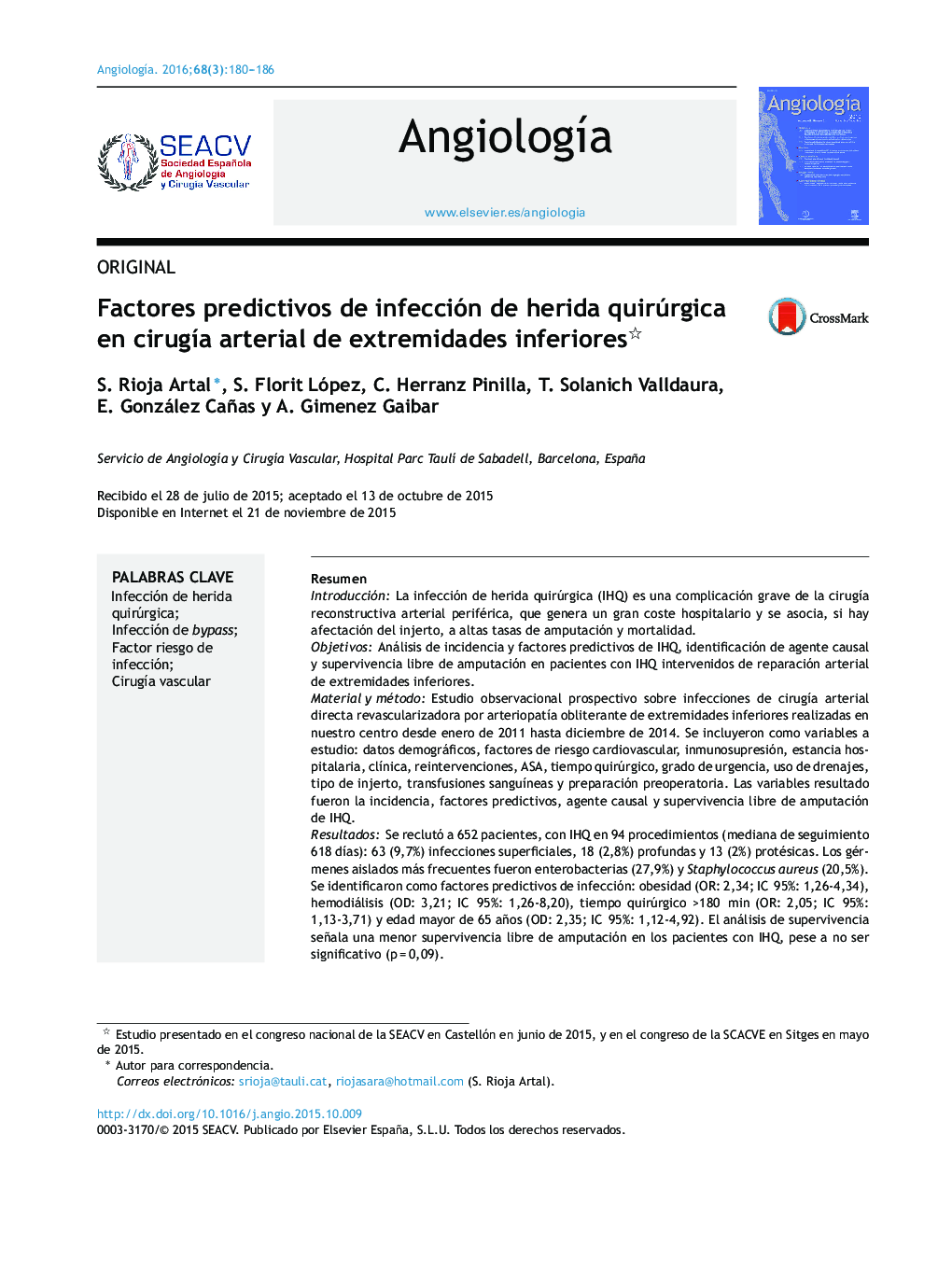| کد مقاله | کد نشریه | سال انتشار | مقاله انگلیسی | نسخه تمام متن |
|---|---|---|---|---|
| 2867281 | 1171080 | 2016 | 7 صفحه PDF | دانلود رایگان |
ResumenIntroducciónLa infección de herida quirúrgica (IHQ) es una complicación grave de la cirugía reconstructiva arterial periférica, que genera un gran coste hospitalario y se asocia, si hay afectación del injerto, a altas tasas de amputación y mortalidad.ObjetivosAnálisis de incidencia y factores predictivos de IHQ, identificación de agente causal y supervivencia libre de amputación en pacientes con IHQ intervenidos de reparación arterial de extremidades inferiores.Material y métodoEstudio observacional prospectivo sobre infecciones de cirugía arterial directa revascularizadora por arteriopatía obliterante de extremidades inferiores realizadas en nuestro centro desde enero de 2011 hasta diciembre de 2014. Se incluyeron como variables a estudio: datos demográficos, factores de riesgo cardiovascular, inmunosupresión, estancia hospitalaria, clínica, reintervenciones, ASA, tiempo quirúrgico, grado de urgencia, uso de drenajes, tipo de injerto, transfusiones sanguíneas y preparación preoperatoria. Las variables resultado fueron la incidencia, factores predictivos, agente causal y supervivencia libre de amputación de IHQ.ResultadosSe reclutó a 652 pacientes, con IHQ en 94 procedimientos (mediana de seguimiento 618 días): 63 (9,7%) infecciones superficiales, 18 (2,8%) profundas y 13 (2%) protésicas. Los gérmenes aislados más frecuentes fueron enterobacterias (27,9%) y Staphylococcus aureus (20,5%). Se identificaron como factores predictivos de infección: obesidad (OR: 2,34; IC 95%: 1,26-4,34), hemodiálisis (OD: 3,21; IC 95%: 1,26-8,20), tiempo quirúrgico >180 min (OR: 2,05; IC 95%: 1,13-3,71) y edad mayor de 65 años (OD: 2,35; IC 95%: 1,12-4,92). El análisis de supervivencia señala una menor supervivencia libre de amputación en los pacientes con IHQ, pese a no ser significativo (p = 0,09).ConclusiónLa supervivencia libre de amputación fue menor en los pacientes con infección de injerto que en aquellos con infección superficial. Encontramos como factores predictivos de IHQ la obesidad, hemodiálisis, edad mayor de 65 años e intervención >180 min. La identificación correcta de estos permitiría establecer estrategias para prevenir la IHQ en cirugía arterial y evitar sus consecuencias.
IntroductionSurgical site infection (SSI) is a serious complication of peripheral arterial surgery. It generates increased hospital costs, and associated with high amputation and mortality rates if the graft is affected.AimsThe aim of this study is to analyse the incidence rate and risk factors of SSI, to identify causal bacterial agents, and amputation free survival rates in patients with SSI undergoing lower limb arterial surgery.Material and methodsA prospective observational study of SSI in peripheral open arterial surgery was performed in our centre from January 2011 to December 2014. The variables studied were: Demographic data, cardiovascular risk factors, immunosuppression, hospital stay, clinical symptoms, re-operations, ASA, surgical time, level of urgency, use of drains, type of graft, blood transfusion, and preoperative skin preparation. Outcome variables were incidence rate and risk factors of SSI, causal agent identification, and amputation free survival rate.ResultsA total of 652 patients were registered, identifying 94 SSI (median follow-up 618 days): 63 (9.7%) superficial infection, 18 (2.8%) deep infection, and 13 (2%) graft infection. The most common bacterial agent was enterobacter species (27.9%), followed by Staphylococcus aureus (20.5%). Obesity (OR: 2.34, 95% CI: 1.26-4.34), haemodialysis (OR: 3.21, 95% CI: 1.26-8.20), surgical time > 180 minutes (OR: 2.05, 95% CI: 1.13-3.71) and older than 65 years (OR: 2.35, 95% CI: 1.12-4.92) were identified as predictors of SSI. Survival analysis suggests a lower amputation-free survival rate in patients with SSI, although it is not statistically significant (P=.09).ConclusionAmputation free survival rates are lower in patients with graft infection than those with superficial infection. Obesity, haemodialysis, over 65 years old, and surgical time > 180 min, were found to be predictors of SSI. The correct identification of these factors could help in establishing strategies to prevent SSI and avoid its consequences.
Journal: Angiología - Volume 68, Issue 3, May–June 2016, Pages 180–186
